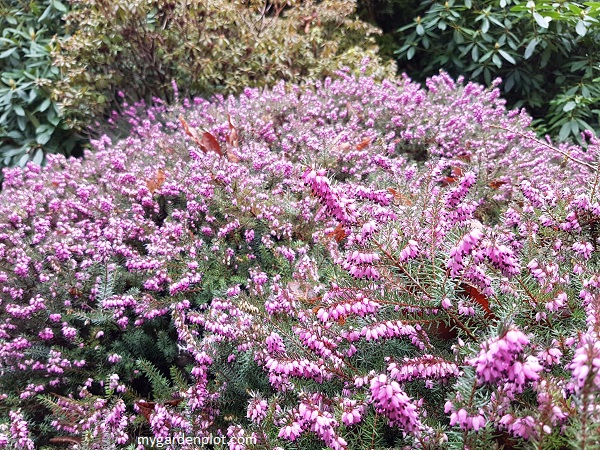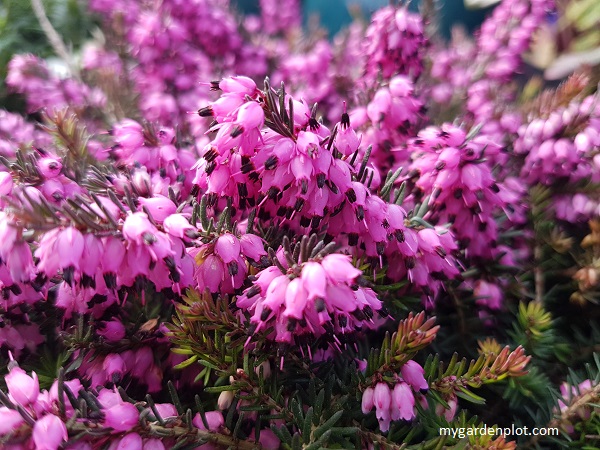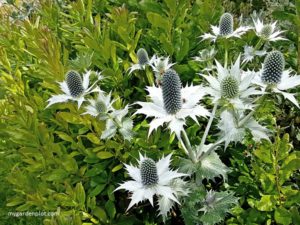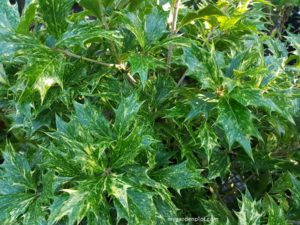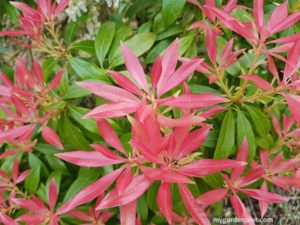About Heather And Heath Flowering Shrubs
Associated with the wide, open spaces in the British moorlands and found throughout Europe, the versatile heather is found in many gardens in the Pacific Northwest – flowering nearly year-round and valued for adding colour in a winter garden and exposed windy sites. Generally, ‘heather’ is the umbrella term for heather and heath. The following guide will help understand the difference between these plants and make the most of this low-growing evergreen shrub in the garden. Below find information on where to plant and how to grow and prune your heather and heath shrubs.
Heather can also be used with container gardening, either on their own or grouped. And because of their long flowering seasons, they can add colour to your garden.
Difference Between Calluna (Heathers) And Erica (Heaths)
The most popular ‘heather’ is actually a heath. But heath is not botanically a heather. Whaaat? So what’s the difference between heather and heath?
While both belong to the Ericaceae family and share similar habitats, Calluna and Erica differ in leaf arrangement, flower structure, bloom time, and species diversity.
The word ‘heather’ has been widely adopted when speaking about either heather or heath. They look so similar. But strictly speaking, heather refers to the hardy genus Calluna. It is also known as Scots heather, Scottish heather, Scotch heather and ling heather. The Calluna is native to Europe and Asia Minor, thriving in acidic, well-drained soils (e.g., moorlands). There is only one species of heather, C. vulgaris, but many varieties are available.
Heath refers to the genus Erica, of which there are more than 700 species plus many varieties. Erica is found in Europe (e.g., Erica “tetralix” in wet heaths) and South Africa (Cape heaths), adapting to diverse habitats including alpine and Mediterranean regions. Most are frost tender, but a few are hardy and very suitable for the Pacific Northwest. Heaths are also referred to as Winter heath and alpine heath.
One distinct visual difference is the shape of the leaf. The heather (Calluna) leaf is more scale-like that overlap, while the heath (Erica) leaf is more needle shape and spaced alternately (see photo comparison below).
Flowering times vary too between heather and heath. Generally, the genus Calluna (heather) blooms mostly from mid-summer and throughout early autumn. In comparison, the genus Erica (heath) blooms mainly from winter to spring.
Their growth and structure differ too. The heather (Calluna) forms dense, low-growing mats with woody, rugged stems that become gnarled with age. And heath (Erica) varies from prostrate to upright shrubs and its stems are often less woody and more flexible.
But does any of this matter? Not really to average gardeners like me. Heathers and heaths are low maintenance, evergreen, acid-loving plants. Your take away? Heathers (Calluna) are best recognized by their scale-like leaves and persistent sepals, while Heaths (Erica) display needle-like leaves and diverse flowering seasons. They combine well in a garden. And if you have a wide area to plant both heathers and heaths, this offers a colourful carpet of mounds flowering at different times of the year.
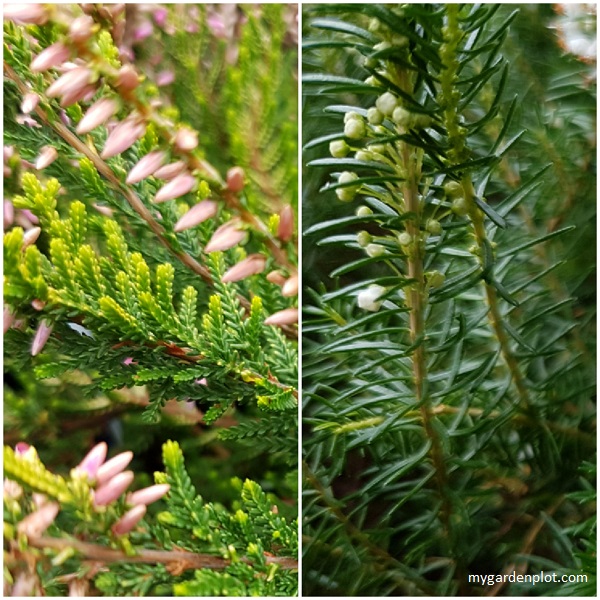
Popular Heath Species And Varieties
The most popular heather varieties are from the cultivar Erica Carnea. There are many types to choose from at the garden centre. Some of the most popular are E. Carnea ‘Springwood White’ with white flowers and the ‘Springwood Pink’ with light pink flowers.
The E. x darleyensis ‘Mediterranean Pink’ is also a popular choice with its pink-lavender spring flowers. Our favourite is the E. x darleyensis ‘Kramer’s Red’ with stunning, pink flowers that brighten dull late-winter days. The natural mounding growth habit makes them ideal as a groundcover, certainly bringing colour to pathways and mixed borders. Plus, they are one of the easiest of heaths to grow and very good for suppressing weeds.
RELATED TOPIC: How To Remove And Prevent Weeds
Daboecia cantabrica (St Dabeoc’s Heath, Irish Bell Heather, Irish Heath)
There is a third genus, Daboecia, that often accompanies Calluna (Heather) and Erica (Heath) using the general term ‘heather’, and its relation to the genus Erica. Daboecia cantabrica, also known as St Dabeoc’s heath (named after St. Dabeoc, a 6th-century Irish saint), Irish bell heather or Irish heath. D. cantabrica is in reference to the Cantabrian Mountains in Spain. It thrives in acidic, well-drained soils in the heathlands, moorlands, and coastal cliffs. As hinted, its native range includes southwestern Europe (Cantabrian Mountains, Iberian Peninsula) and western Ireland.
It is an evergreen, long-flowering small shrub with a spreading habit similar to heather and heath. Perfect as an ornamental in rock gardens, borders, or as ground cover. Cultivars like ‘Alba’ (white flowers) and ‘Bicolor’ enhance garden diversity. The nodding, bell-shaped flowers range from purple-pink to white. Blooms late spring through to autumn until the first frost. Daboecia is easy to care for and enjoys similar sunny and soil conditions as heather and heath. Tolerates mild winters but is sensitive to waterlogged conditions. Suitable for zones 7 – 9.
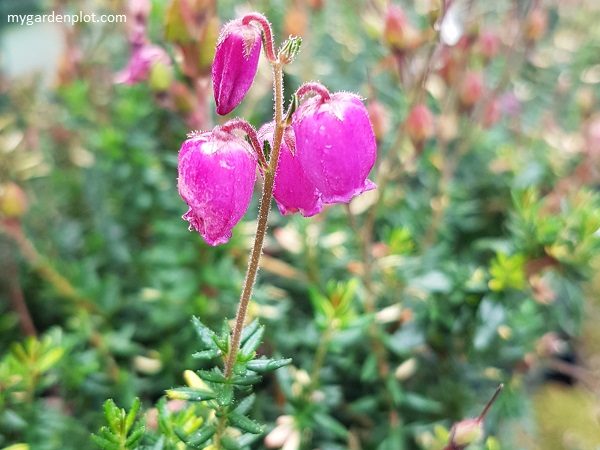
Heather And Heath At A Glance
Type: Evergreen Shrub
Location: Full sun (provide afternoon shade in hot climates)
Flowering Interest: Heather (mid-summer to early autumn); Heath (late winter to spring, some start blooming as soon as late autumn)
When to Plant: Spring or early fall for root establishment
When To Prune: Trim after flowering (either late winter or early spring)
- Heather (Calluna) – Late summer blooms; prune in spring
- Heath (Erica) – Varying bloom times; prune post-flowering
Size: Varies –up to 50 cm (20 inches) in height and 90 cm (35 inches) in spread
Plant Hardiness Zones: 5 – 9
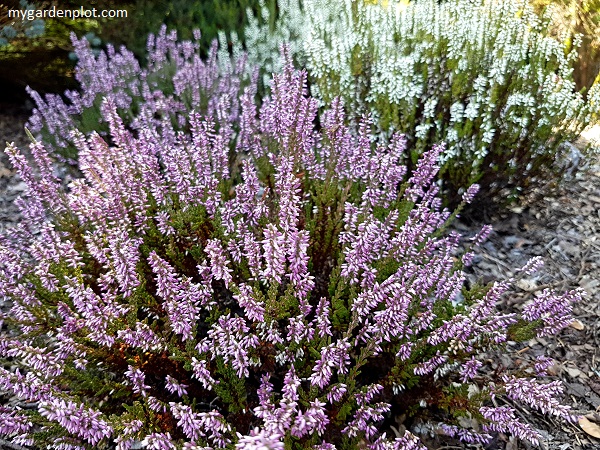
Where To Plant And How To Grow Heather
Heathers and heaths thrive in our cool summers planted in a location that receives full sun. Provide afternoon shade to avoid intensive summer heat.
They need acidic (pH 4.5–6.0), well-drained soil but tolerate average alkaline soil conditions. Avoid clay. Adding peat moss, pine needles, or ericaceous compost when planting the heather or heath helps retain moisture and will permit good drainage during winter. Mulching also suppresses weed growth and maintains soil acidity.
Heathers and heaths do not like excessive water at their roots. Keep soil moist but not waterlogged. Water young plants regularly; established plants are drought-tolerant but benefit from occasional deep watering.
Apply acid-loving plant fertilizer (e.g., for rhododendrons and azaleas) in early spring. Refrain from overfertilizing but ensure it is watered regularly until it is established. Adding mulch in spring will help conserve moisture in summer and keep their roots cool in scorching sites.
Winter care is minimum; mulch base to protect roots from prolonged winter temperatures. Some varieties are cold-hardy; shield from heavy snow if needed.
Take semi-ripe cuttings in summer or layer stems. Seeds are
less reliable.
By tailoring care to these guidelines, Heather and Heath will thrive, offering year-round color and structure to your garden.
How To Prune Heather And Heath
Heathers and heaths benefit from a light prune to keep tidy and improve blooming. Using pruning shears or hand pruners, trim off about 2.5 cm (1 inch) after it flowers and before the new growth begins. Remove any damaged growth.
Heather (Calluna) blooms late summer to fall on current year’s growth. Prune in early spring before new growth, trimming lightly to shape. Avoid cutting into old wood.
With Heath (Erica) prune immediately after flowering (timing will varies by species). For spring bloomers (e.g., Erica carnea), prune in late spring; for summer bloomers (e.g., Erica cinerea), prune in late summer. Trim flowered stems, avoiding old wood.
Older or neglected heathers and heaths may become woody and lose their vigour. At this stage, not much can be done but to replace them.
RELATED TOPIC: Buyer’s Guide On How To Choose Hand Pruners (Secateurs)
Pests, Problems and Troubleshooting
Heathers and heath are usually trouble-free and deer resistant.
Common mistakes include planting in alkaline soil, overwatering, incorrect pruning times, or insufficient sunlight.
Watch for root rot (avoid overwatering), spider mites, and aphids.
Ensure good air circulation with a pruning schedule.
Treat chlorosis (yellow leaves) with chelated iron.
